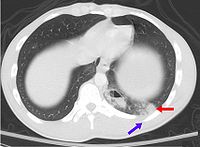
Photo from wikipedia
OBJECTIVES The study aimed to examine the risk factors for long-term decline in pulmonary function after anatomical resection for lung cancer and the effects of the decrease on survival. METHODS… Click to show full abstract
OBJECTIVES The study aimed to examine the risk factors for long-term decline in pulmonary function after anatomical resection for lung cancer and the effects of the decrease on survival. METHODS We retrospectively examined 489 patients who underwent anatomical resection for lung cancer between 2010 and 2020. Pulmonary function tests were performed preoperatively and at 1, 3, 6 and 12 months after surgery. The lower interquartile medians of the reduction rates of forced expiratory volume in 1 s and vital capacity at 12 months after surgery were taken as the cut-off values of risk factors for the decrease in post-operative pulmonary function. RESULTS Forced expiratory volume in 1 s and vital capacity decreased the most in the first month after surgery and then gradually recovered. Vital capacity continued to increase even after 6 months post-surgery, whereas forced expiratory volume in 1 s stabilized. Multivariable logistic analysis showed that the number of resected segments (odds ratio, 2.09; 95% confidence interval, 1.12-3.89; P = 0.019) was a risk factor for the decrease in forced expiratory volume in 1 s at 12 months, and the numbers of resected segments (odds ratio, 1.36; 95% confidence interval, 1.13-1.63; P < 0.001) and post-operative complications (odds ratio, 2.32; 95% confidence interval, 1.01-5.35; P = 0.047) were independent risk factors for decrease in vital capacity. Multivariate cox regression analysis showed that the decrease in vital capacity at 12 months was significantly associated with overall survival (hazard ratio, 2.02; 95% confidence interval, 1.24-3.67; P = 0.004). CONCLUSIONS Long-term decrease in vital capacity, which was influenced by the number of resected segments and post-operative complications, adversely affected survival.
Journal Title: Japanese journal of clinical oncology
Year Published: 2022
Link to full text (if available)
Share on Social Media: Sign Up to like & get
recommendations!